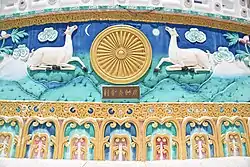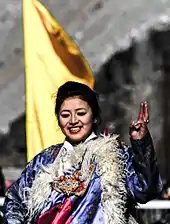Ladakh Buddhist Association
Ladakh Buddhist Association (LBA) is an organization in Ladakh, India concerned with interests of Buddhists in Ladakh.[2] It was founded in 1933 by King Jigmet Dadul Namgyal, Kalon Tsewang Rigzin, Kalon Bankapa Morup Gyaltsan and Munshi Sonam Tsewang.[3][4]
Ladakh Nangpay Tsoksdus | |
 Ladakh Buddhist Association | |
| Abbreviation | LBA |
|---|---|
| Motto | Welfare of people of ladakh |
| Predecessor | Tsewang Thinles |
| Successor | PT Kunzang |
| Formation | 1934 |
| Founders | Kalon Tsewang Rigzin, Munshi Sonam Tsewang, Kalon Bankapa Murup Gyaltsan |
| Type | Socio-Religious / Charitable |
| Purpose | Maintaining peace and stability in ladakh region |
| Headquarters | Leh, India |
| Location |
|
Region | Ladakh, India |
Membership | 24356 |
Official language | Bhoti, English |
Vice President[1] | Richen Namgail |
Key people | Vice president Rinchen Namgail |
| Subsidiaries | LBA Youth Wing |
| Affiliations | Buddhist Society of India |
| Website | Official handle |
Objectives
It has the aim of looking after the Buddhist interests, bringing social reforms in Ladakhi society and to preserve its art, culture, language and tradition.
Organization structure
The LBA consists of the Parent Department, the Youth Wing and the Women's Wing and units located in villages that are meant to address local issues. LBA has its unit branch offices in the outreach representing a cluster of villages. These units facilitate and work closely with the community heads and their own village representatives as well as their women and youth groups.[5]
History
In 1989, there were violent riots between Buddhists and Muslims, provoking the Ladakh Buddhist Association to call for a social and economic boycott of Muslims, which was lifted in 1992. In early 2000, representatives of the LBA claimed that many Buddhist women were taken forcibly from their home villages and forced to convert to Islam, and accused the state government in Jammu and Kashmir of allowing this to happen.[6][7]
Controversy
Observers have noted that the LBA has been allying with the RSS, BJP, and other right-wing Hindu nationalist groups with a pronounced anti-Christian and Islamophobic bias since the 1990s. Martijn van Beek has considered the rhetoric of the LBA and its leader to have grown more communal and "saffronised" in part because of the role Ladakh plays in the Kashmir conflict and the LBA's advocacy for the autonomy of Ladakh. Beek summarized the situation as such: "Thus, while the LBA and some Buddhist political leaders may be willing to share a platform with the sangh parivar to promote their agenda for Union Territory status, Hindutva as such would not appear to have much appeal in a region like Ladakh. Yet despite this limited appeal of Hindutva, the saffronization of education, of the media, and of public life in general are likely to strengthen even further the perceived validity and necessity of communal idioms".[8]
The LBA has spread anti-Muslim information and conspiracies. The LBA has demonized the Ladakhi Muslims as untrustworthy and extremist for political leverage. The LBA promoted the "Turtok incident" where 24 young Kargili Muslims were arrested for harboring weapons in their village near the Line of Control in 1999 as an example to not trust the Muslims. The Kargili Muslims were cleared of all charges in 2001 and it was proven that local police fabricated the evidence.The LBA and other local media didn't give this aftermath any coverage. The LBA has also claimed a Muslim takeover of Ladakh where the Buddhists will be outnumbered by the Muslims in the near future.[8] The LBA has claimed that the Ladakhi Muslims are luring Buddhist women to marry them and forcing them to convert to Islam in which the case of Stanzin Saldon marrying a Muslim man is set as an example. Saldon herself responded to these claims by stating "The statement of LBA is false and concocted, an effort to suppress and threaten the rights of individual." Local politicians and Muslim organizations also expressed concern that the LBA is trying to disturb communal harmony.[9][10]
Gallery
.jpg.webp) Ladakhi Buddhist monks
Ladakhi Buddhist monks Traditional instruments
Traditional instruments The Chortens or Buddhist Stupas at Themis Monastery, Ladakh
The Chortens or Buddhist Stupas at Themis Monastery, Ladakh Gold Plated Buddha
Gold Plated Buddha Ladakhi folk dance at Kargil
Ladakhi folk dance at Kargil.jpg.webp) Ladakhi Buddhist nuns of Ladakh Nuns Association
Ladakhi Buddhist nuns of Ladakh Nuns Association Bodhisattva B. R. Ambedkar statue at Leh
Bodhisattva B. R. Ambedkar statue at Leh
References
- "In Conversation with Dr. Tundup regarding Kalachakra (Tuskor wangchen)".
- Varagur, Krithika (1 June 2018). "An interfaith marriage that stirred up trouble in Leh". The Caravan. Retrieved 7 December 2019.
- Das, Shaswati (7 August 2019). "With J&K bifurcation, India gets its first Buddhist dominated Union Territory". mint. Retrieved 28 September 2020.
- http://www.ladakhstudies.org/lsbackissues_assets/LS16.pdf
- "Archived copy". Archived from the original on 11 September 2014. Retrieved 10 September 2014.CS1 maint: archived copy as title (link)
- Tundup Tsering and Tsewang Nurboo, in: Ladakh visited, Pioneer, 4/12/1995.
- Conversions: LBA blames govt The Tribune Online edition, 12 January 2000
- Beek, Martijn van (2011). Hindu Nationalism and Buddhist Radicalism in Ladakh. Asia-Pacific Center for Security Studies.
- "Buddhist woman's wedding with Muslim sparks tension in Ladakh". Hindustan Times. 10 September 2017. Retrieved 15 October 2020.
- Raj, Suhasini; Gettleman, Jeffrey (12 October 2017). "On the Run for Love: Couple Bridges a Buddhist-Muslim Divide". The New York Times. ISSN 0362-4331. Retrieved 15 October 2020.